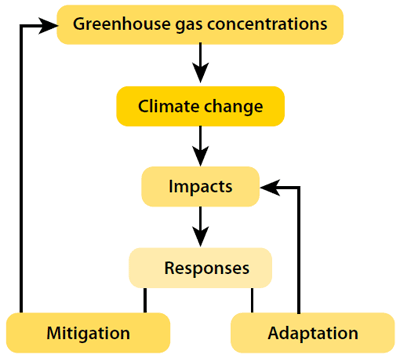
- TroFCCA
- Forest and adaptation
- What is adaptation
What is adaptation
Addressing the impacts of climate change
Climate change is already having a dramatic effect on people and natural resources. During the past century, the Earth has warmed by approximately 0.7°C. These climatic changes and their effects have aggravated climate variability, shown in the more frequent droughts and storms and more erratic or intense rainfall patterns worldwide. Unless we take measures to address climate change, temperatures could rise even more rapidly, increasing by 1.4 – 5.8°C during the next century. This means that aggravated climate variability is also projected to intensify significantly in the future.
The effects of aggravated climate variability have already had a severe impact on economic sectors in developing countries (e.g. on rain-fed agriculture, health, infrastructure) and it is clear that addressing climate variability and change will be important for the long-term success of development. Poor people in developing countries are particularly exposed to the effects of climate change, not least because they often live and work in the very areas where natural disasters most often occur: floodplains, mountainsides and deltas.
The world faces two major challenges. We must reduce the vulnerability of those sectors that are most sensitive to climate variability, such as water resources, agriculture and forests. And we must also 'climate proof' future development activities.
The Intergovernmental Panel on Climate Change (IPCC) defines adaptation to climate change as adjustments in natural or human systems in response to actual or expected climatic stimuli or their effects, which moderate harm or exploit beneficial opportunities. Adaptation addresses the impacts of climate change, presenting different strategies to mitigation of climate change, which addresses the causes of climate change.
Both approaches are needed. On the one hand, even with strong mitigation efforts, the climate will continue changing in the next few decades and adaptation to these changes is necessary. On the other hand, adaptation will not be able to eliminate all negative impacts and mitigation is crucial to limit changes in the climate system.
While forests already have a place in mitigation science, policy and practice, their role in adaptation still remains relatively unrecognised and needs to be built up. The links between forests and adaptation are two-fold: first, forests play a role in the adaptation of broader society (‘forests for adaptation’); second, adaptation is needed for forests (‘adaptation for forests’). In the first case, the link exists because forests provide ecosystem services that contribute to human wellbeing and reduce social vulnerability. In the second case, the link exists because climate change is an important driver of changes in forests.

For more information about the differences and synergies between adaptation and mitigation, click here.
How is adaptation different from business as usual?
Adaptation is not distinguished by specific activities or measures, but by the whole process, especially in relation to planned adaptation. Conventional development activities can result in co-benefits for adaptation but they can also result in mal-adaptation, meaning that they increase the vulnerability of certain systems to climate change instead of reducing it. For example, a dam built to address water-related problems upstream can disrupt the water flows on which downstream communities depend, making them more vulnerable to projected future droughts.
The IPCC defines vulnerability as the degree to which a system is susceptible to, or unable to cope with, adverse effects of climate change, including climate variability and extremes. The degree of vulnerability depends on the character, magnitude, and rate of climate variation to which a system is exposed, its sensitivity, and its adaptive capacity.
Planned adaptation to climate change involves the use of information about past, present and expected future climate conditions to develop activities that reduce vulnerability and increase wellbeing of people, or to evaluate the sustainability of current and planned actions, strategies and policies under climate change. Actions are planned on the basis of vulnerability assessments — a process unique to the adaptation discipline — which analyse who is vulnerable to what, why this vulnerability is occurring or will occur, and how this vulnerability might increase in the future if no action is taken.
Further reading: Pramova, E 2011, ‘Adaptation — just a fancy new name?’, Forests Blog, CIFOR, Bogor, Indonesia.
CIFOR’s work on adaptation
CIFOR’s research on adaptation is concerned with:
- bringing climate change adaptation into forest management
- mainstreaming the role of forests into policies and strategies for the adaptation of people to climate change.
Our twin goals are to ensure that adaptation policy and practice adequately address the need to protect forest-dependent livelihoods and sectors from adverse climate change, and to ensure that adaptation strategies are adequately incorporated into improved forest management.
For more information on CIFOR's adaptation research projects, click here.


